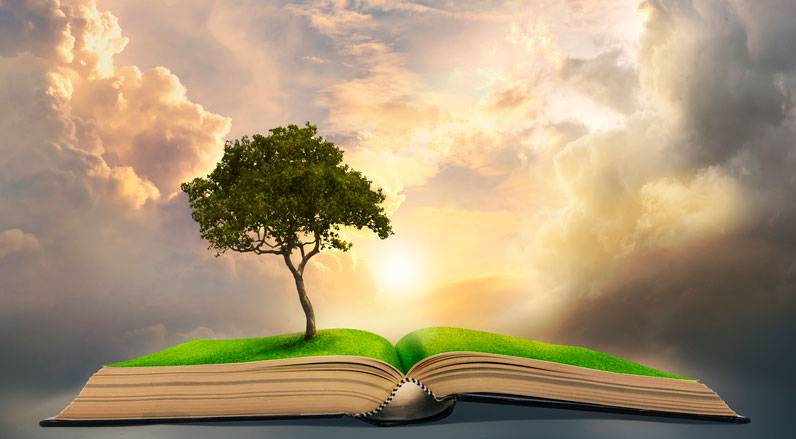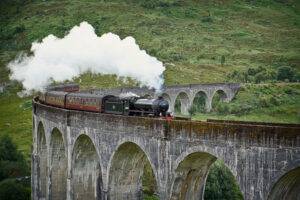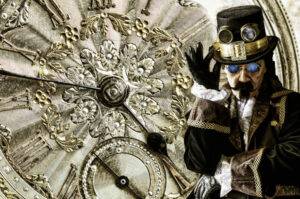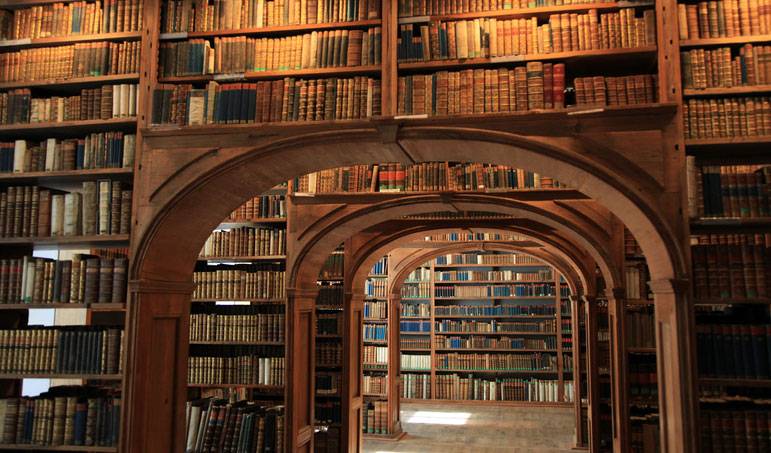Written by Scott Wilson

Like the hiss of a jagged sword slicing past your ear or the roar of a spacecraft entering the atmosphere of a strange planet, genre echos through every piece of creative writing.
Whether or not the author chooses consciously to conform to an existing genre or decides to break new ground, genre will attach to whatever they create. Even so-called non-genre, or literary, fiction is itself a sort of genre. Genre is a tool that is used by:
- Writers, to guide story and expectations
- Critics, to categorize and analyze creative works
- Publishers and Booksellers, to stock and market books to their target audiences
- Readers, to find and read works that align with their aesthetic preferences
Understanding and mastering genre is not optional for creative writers. But it’s not easy, either.
How Genre Defines Your Creative Writing Work
 Writing genres can be a stew of different elements that new writers find hard to digest.
Writing genres can be a stew of different elements that new writers find hard to digest.
Genre is a hot topic in the world of creative writing. You won’t get far in the average creative writing program before you get into some kind of argument over how to classify some piece of work.
That’s because genre is necessarily subjective. There is no centralized Genre Board that puts a stamp inside the front cover of each new book that is released. The American Literature Association does not maintain an official list of genres that authors are required to choose from among before beginning their next story.
The reality of a serious writer is a reality of many voices, some of them belonging to the writer, some of them belonging to the world of readers at large.
~ Aberjhani
Our literary genres today are simply social conventions, conventions that evolve over time with community expectations and tropes. It’s impossible to come up with a genre writing definition that will satisfy everyone. At the same time, genre is descriptive enough to be indispensable for readers and writers alike.
Genre is so difficult to get a grip on because it is effectively a kind of rolling consensus.
Genre is defined by the authors themselves, by critics who seek to interpret works, by readers deciding what they like to read, and by publishers looking to market those works.
And those definitions change all the time.
The Rapid Evolution of Genre in Writing
Take the ancient and well-established genre of fantasy, for example. Myth and legend may be the oldest genres of fiction, stretching back to our earliest recorded works. The Epic of Gilgamesh and Beowulf both fall into the realm of fantasy.
But fantasy has evolved as its readers and writers have.
Fantasy writing today is nothing like what it was prior to Tolkien’s tales of Middle Earth reaching and shaping the expectations of readers. Epic works like The Lord of the Rings and the Chronicles of Narnia set a standard for their writing genre, and subsequent tales are inevitably judged by those standards.
With the pace of publishing increasing rapidly and the ease of finding literature to taste getting easier and easier, genre is evolving at a lightning pace.
Writing Sub-Genres Have Become Ever More Niche With the Internet
 The internet has honed genre writing down to a science. Niche and sub-niche content has become easy to search and find through markets like Amazon. Although the appeal may be restricted to a relatively limited audience, the difference today is that they can all easily find it—you don’t have to have the mass-market appeal that used to be required to get picked up by brick-and-mortar bookstores.
The internet has honed genre writing down to a science. Niche and sub-niche content has become easy to search and find through markets like Amazon. Although the appeal may be restricted to a relatively limited audience, the difference today is that they can all easily find it—you don’t have to have the mass-market appeal that used to be required to get picked up by brick-and-mortar bookstores.
That kind of specificity comes with very distinctive expectations, however. Niche works are often expected by readers to follow a very specific formula—hit a certain set of plot points, come in at a particular word-count, feature a distinctive type of characters. If you’re aiming for success in the Highlander romance niche, you had better have an evil Englishman somewhere in the story—and heaven help you if there’s not a shirtless man in a kilt on the cover.
While this kind of narrow, formulaic approach is seen as a constraint by some authors, it represents a kind of feedback loop that allows writers to reach very specific audiences. If you plan to make a career out of creative writing, understanding and selling to the market is door you’ll need to open. Genre expectations give you the key.
The genre of writing you pick for any given story you choose to tell will define how it is viewed and what readers expect before you even put down the first word. So understanding how genres in writing work and how to use them in your own pieces is a key part of being a creative writer today.
Picking a Writing Genre Can Be Empowering for Creative Writers
Understanding what genre is and how genres are defined is the only way that you can understand how your own work will be perceived. And developing that kind of knowledge allows your writing to grow and operate on multiple levels as your stories unfold. Genre offers subtext to your stories. Adding a new entry to the catalog of any particular genre expands what the field has to say.
The many types of genres in writing offer an avenue for every writer to explore and expand their craft.
Equally important for some writers is the sense of context that genre creates for their writing. Not only can it help shape creative works by offering standards to aim at, but it also provides a set of expectations that can be subverted to critical effect. For example, The Red Badge of Courage by Stephen Crane would not have had the effect on readers that it did without a long tradition of glorious war stories from a genre that it mimicked, then up-ended with the hero’s cowardice.
Pure formless creativity and invention are wild and dangerous things. To develop a coherent story and a world that is true enough for readers to believe is a tricky business. Having a set of general rules to follow and expectations to meet brings focus.
Beyond that, the very act of channeling your imagination into a defined form and to tell your own story within those rules is a challenge that rewards the creative spirit. Finishing a novel can feel very much like clicking the last piece into place on a jigsaw puzzle. The picture on that puzzle is the genre. When everything lines up to match, your sense of satisfaction and accomplishment is immense.
Writing Genres Give Readers the Stories They Are Looking For
 Genre is a vital part of how readers develop their tastes and find works they will appreciate. As often as not, if you ask anyone what it is they like to read, they’ll reply in the form of a genre. They know exactly where to go in their local bookstore. Recommendation algorithms on their preferred online stores will throw suggestions from those genres at them.
Genre is a vital part of how readers develop their tastes and find works they will appreciate. As often as not, if you ask anyone what it is they like to read, they’ll reply in the form of a genre. They know exactly where to go in their local bookstore. Recommendation algorithms on their preferred online stores will throw suggestions from those genres at them.
Those stores, and the publishers who print novels and magazines, live and die by genre sales. Some publishers either specialize in or dedicate certain of their imprints to particular genres. Editors, illustrators, and agents may also specialize by genre. Critics, industry awards, and writing groups are often dedicated to different genres. Even creative writing programs offer specializations or concentrations in certain writing genres.
Ultimately, however, genre in writing persists and is needed for the reader. The evolution of genres in writing has largely been in the hands of publishers and book sellers, all seeking to match works with groups of readers who will find them appealing.
Genre in Writing May Be Determined in Different Ways
Genres in writing are not absolutes. Any given work can fall into many different genres depending on how the term is being applied. For example, the two big categories of writing are the genres of poetry and prose. Every work will fall into one of those, as well as others.
The most common ways of categorizing genre are:
- By literary technique and style
- By length
- By theme
- By setting or character type
Each of these different genres of writing will share certain characteristics, but may diverge through other categories. For example, there are works that have a common science fiction theme, but use technique and style more common to literary fiction. The Handmaid’s Tale, by Margaret Atwood, is one example… set in a dystopian future, it nonetheless develops characters and explores deep themes common to other classic works of literature.
 Douglas Adams’ The Hitchhiker’s Guide to the Galaxy series is just as much science fiction as The Handmaid’s Tale, but crosses over into the comedy genre as well. And J.K. Rowling’s Harry Potter series hits genre buttons ranging from the Bildungsroman to fairy tales to school stories to allegory, all while firmly entrenched in the realm of fantasy.
Douglas Adams’ The Hitchhiker’s Guide to the Galaxy series is just as much science fiction as The Handmaid’s Tale, but crosses over into the comedy genre as well. And J.K. Rowling’s Harry Potter series hits genre buttons ranging from the Bildungsroman to fairy tales to school stories to allegory, all while firmly entrenched in the realm of fantasy.
In addition to crossing genres, creative writing works also may fall into sub-genres. The most writing genres evolve branches over time. In fact, science fiction, one of the biggest and most popular genre examples in writing today, is simply a sub-genre of the larger category of speculative fiction.
Sub-Genres Sprout From Pop-Culture in Unexpected Ways to Offer Something Uniquely Tailored to Every Audience
 As a general rule, a genre only becomes a genre when there are enough works that hold the same characteristics to be viewed as a group. When works that break new ground are released, they may or may not inspire other writers to create tales with the same themes and style. And as new works are created, old ones may be re-evaluated and placed in different genres by new generations of readers.
As a general rule, a genre only becomes a genre when there are enough works that hold the same characteristics to be viewed as a group. When works that break new ground are released, they may or may not inspire other writers to create tales with the same themes and style. And as new works are created, old ones may be re-evaluated and placed in different genres by new generations of readers.
To give just one example of this process, consider the evolution of the genre of steampunk.
Steampunk is a sub-genre of cyberpunk, which already lies at the bottom of a long list of other sub-genres of fiction:
- Speculative fiction
- Science Fiction
- Dystopian and Utopian science fiction
- Cyberpunk
- Steampunk
- Cyberpunk
- Dystopian and Utopian science fiction
- Science Fiction
In addition, steampunk works almost all fall into the addition speculative fiction category of alternate history, since they imagine a historical era not as it was, but as it might have been. Some can be called Westerns; others are post-apocalyptic, taking another bite out of the dystopian genre apple.
The first proto-steampunk works were published in the ’70s and ‘80s by authors such as Tim Powers and James Blaylock, but it was 1990’s The Difference Engine, by William Gibson and Bruce Sterling that really kicked off steampunk as a genre—probably because Gibson and Sterling were also two of the prime movers in cyberpunk itself.
As steampunk caught on and became more popular, not only did newer works emerge to expand the genre (including its own sub-genres), but older novels that included or inspired the same elements were sometimes described as steampunk. Seminal works like H.G Wells’ The Time Machine and Jules Verne’s Twenty Thousand Leagues Under the Sea are sometimes found in lists of steampunk works.
Why not just do away with genre, and consider each piece on its own merits? Ultimately, many scholars and creative writing professionals are able to do just that.
In the same way that a rock musician can understand, appreciate, and adapt techniques from the classical world, good writers recognize and respect good writing craft, regardless of genre.
But genre is also a part of artistic judgement. A creative work can be assessed by how well or poorly it conforms to the expectations of the genre it is aimed at.
How To Succeed as a Creative Writer in Different Types of Writing Genres
To be clear, you don’t need to pick a genre lane if you don’t want to. Iain Banks had no problem at all jumping back and forth between epic sci-fi novels, psychologically complex literary fiction, rollicking travelogues, and even poetry. All of it earned critical acclaim.
When J.K. Rowling decided she needed a break from fantasy, she picked up the pen name of Robert Galbraith and popped over into crime fiction instead.
But most creative writers aren’t made of the same stuff as Banks or Rowling. It may be that a particular genre is what inspires you to write in the first place. Perhaps it’s a fascination with the subject matter that draws you in to a particular kind of world. Or maybe it’s just a raw commercial calculation, playing to the market and what is most publishable.
In any case, deciding the genre or genres you are interested in writing in is only one part of the process. Each genre has its own unique path to success.
The Many Genres of Writing in English Literature
To help you get started, we’ve got a whole list of writing genre guides that take you step-by-step through the process of becoming a successful writer in that field.

Literary fiction is the non-genre genre of creative writing. It includes works that are too non-traditional to fit cleanly in existing genres or that focuses on characterization and exploration of deep truths over conventional plot or narrative structures. Much of the pantheon of great novels and works that are used in teaching creative writing fall into the literary fiction genre.
Fantasy authors excel in creating imaginary worlds where fantastic creatures roam, magic and the supernatural shape character’s lives, and medieval settings call classic mythology to mind. Fantasy is one of the oldest of genres in both Eastern and Western writing traditions, and its popularity continues to ensure steady careers for well-trained fantasy writers.
There is a fascination with the macabre and surreal that keeps horror novels on the top-seller lists year after year. From Anne Rice to Stephen King, some of the most commercially successful modern authors have chosen this genre. And with classics from Shelley and Poe as part of the enduring tradition of literature, a career in horror offers creative writers a shot at both fortune and fame.

Mystery, or crime, fiction embraces a whole spectrum of entertaining works from Agatha Christie’s classic detective novels to the hard-boiled works of Dennis Lehane. Writers who have the talent to deliver an intricate plot and keep readers engaged with a steady stream of clues, but still make the reveal and resolution a rewarding surprise, have a bright future in the mystery genre.
The Western genre is both relatively new and distinctively American in nature. Following in the footsteps of Louis L’Amour and Max Brand is no easy task, but there is plenty of life in the humble Western, as works by Cormac McCarthy and Larry McMurtry have shown. Western writers may or may not need a ten-gallon hat, but the definitely need story-telling skills and a strong set of research skills.
Young adult works often combine other genres into stories that deal particularly with the interests and concerns of teenagers. Whether it’s a mix of fantasy and school, like Harry Potter, or pure works that explore contemporary problems and challenges like the classic The Outsiders, young adult novels can shape the perspectives and growth of a generation. Young adult writers have to develop not only a knack for telling stories cleanly and understandably, but also for tapping into the zeitgeist of their target audience.

Science fiction uses the prism of technology and time to explore both exciting theoretical science and social mores and consequences of humanity today. Science fiction is a genre that has a robust demand and strong traditions. Although it can be tough to break into sci-fi, studying creative writing offers the kind of analytical tools and techniques that can make it happen.
The genre of short story is one rooted in length rather than subject. A short story can be told in almost any of the other genres listed here, but it is a form that requires its own set of skills and sensibilities. Creative writing degrees are one of the best places for writers to polish up their ability to deliver the crisp, clear, meaningful prose that is needed to build a successful short story.
Making people laugh is a rare skill in any kind of artistic endeavor. Comedic writing has a long and honorable history in the world of dramatic literature, serving as one of the first genres recognized by the Greeks. Comedy often crosses other genre boundaries, with tendrils in horror, science fiction, and crime. But pure comedies in the form of satire and parody serve important roles in social commentary as well as entertainment.
Writing historical fiction comes with a set of guard rails that play directly to the strengths of creative writers: research offers a glimpse of the world as it once was, and imagination fills out the humanity of those times. While the historical setting can be one grounded firmly in reality, like Hilary Mantel’s acclaimed Wolf Hall, it can also serve as a portal to the fantastical, as in Susanna Clarke’s incredible Jonathan Strange & Mr. Norrell.




